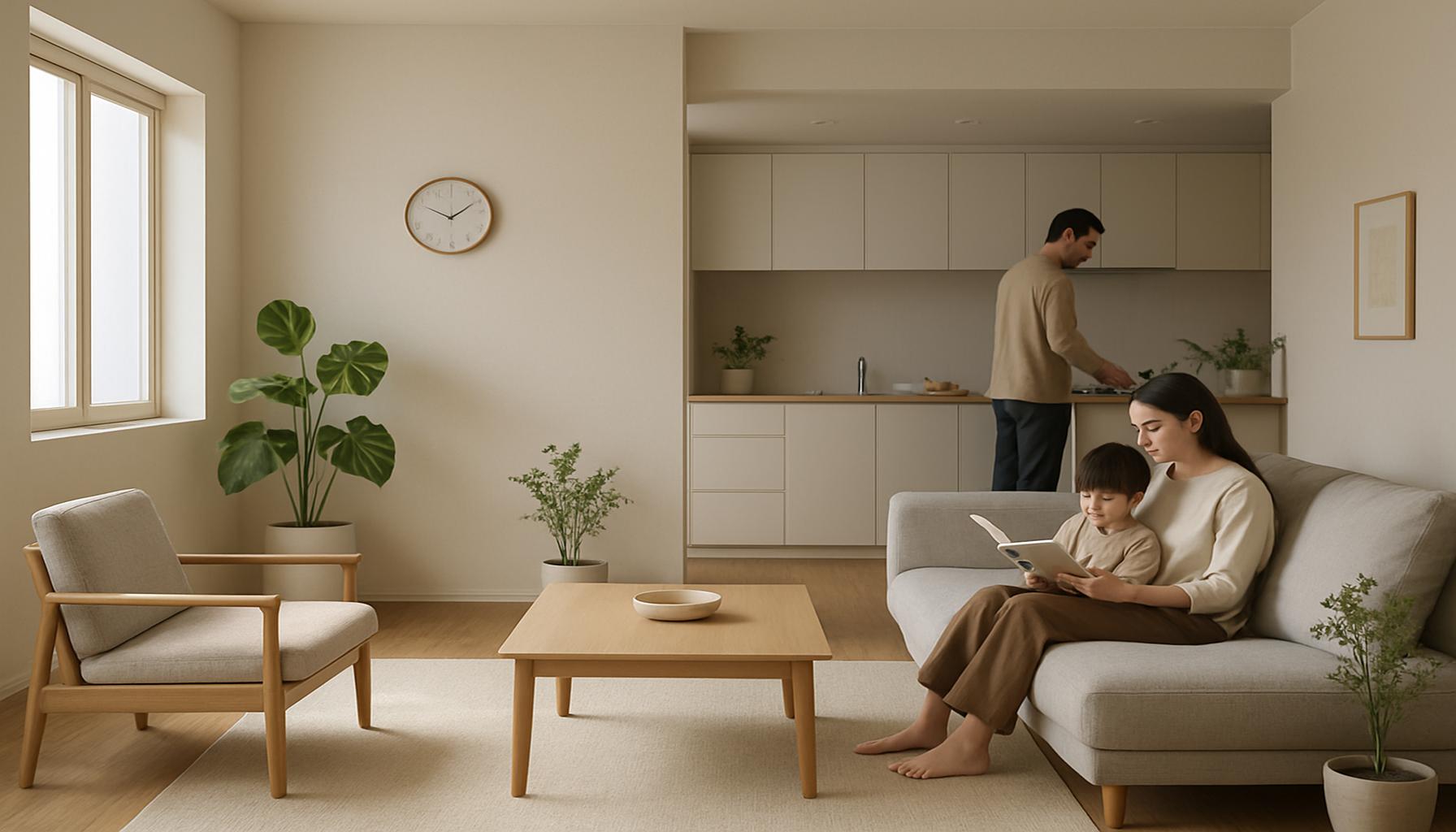Minimalism in Family Life: Strategizing the Daily Routine to Improve Dynamics and Efficiency at Home

Understanding Minimalism in Family Life
As families navigate the complexities of modern living, the accumulation of excess items and commitments can often lead to feelings of overwhelm. Embracing minimalism in family life encourages a paradigm shift, enabling families to streamline their environments and muffle the noise of daily chaos. By embracing principles of minimalism, families not only cultivate a place of serenity but also foster deeper connections among family members.
The benefits of minimalism extend beyond aesthetics. For one, reducing clutter within personal spaces has been shown to significantly lower stress levels. Research reveals that individuals who maintain a tidy home report higher satisfaction and lower anxiety. This newfound tranquility can translate into more focused interactions, allowing family members to engage in meaningful conversations and activities devoid of distractions.
Moreover, adopting a minimalist approach can introduce time-saving strategies into daily routines. Families can eliminate unnecessary commitments that sap energy and leave little room for relaxation or quality time together. This may include re-evaluating extracurricular activities or community obligations to ensure they align with family goals and values.
Practicing Minimalism with Family Strategies
Implementing minimalism effectively requires thoughtful planning and commitment. Here are a few strategies families can integrate:
- Identifying non-essential activities: Assessing which routines drain energy can create opportunities to streamline schedules. For example, a family might decide to cut back on excessive screen time or prioritize less frequent but more engaging outings.
- Establishing a shared family calendar: By maintaining a collective family calendar, members can better manage their time, optimize schedules, and reduce the likelihood of overcommitting to activities.
- Creating designated spaces: Assigning specific areas for particular activities, such as homework, crafts, or family gatherings, can minimize distractions and help maintain focus during those times.
Incorporating these minimalist practices into family life not only paves the way for a more organized household but also enhances overall well-being. Beyond the physical decluttering of space, minimalism invites families to streamline their emotional landscape as well, opening pathways to more profound connections, shared joy, and a deeply fulfilling collective experience.

As families prioritize what truly matters and shed the excess, they often discover that less truly leads to more. This philosophy extends to creating memories, cultivating relationships, and ultimately, enriching family life. Embrace the journey into minimalism and explore how it can redefine your family’s dynamics.
DISCOVER MORE: Click here to simplify your digital space
Practical Approaches to Embracing Minimalism
In today’s hectic world, families often find themselves overwhelmed, not just by their belongings but also by their commitments and technology overload. Embracing minimalism is a transformative journey that centers on cutting out the excess in various facets of life, ultimately leading to a more harmonious and efficient family environment. To truly integrate this philosophy, families must first take stock of their current routines and identify opportunities to streamline their lives. This process goes beyond mere decluttering; it shapes a lifestyle that values time, space, and mental clarity.
A critical first step in this journey is decluttering the home. This doesn’t have to be a daunting task. Start small by focusing on one room or even a single drawer at a time. Encourage each family member to evaluate their belongings using guiding questions like: “Do I use this item regularly?” and “Does this bring me joy?” This practice promotes mindfulness, allowing family members to genuinely appreciate their possessions while learning the valuable skill of letting go of items that no longer serve their needs. It’s an exercise in gratitude and intention, invigorating living spaces and mental states alike.
Moreover, families should not overlook their emotional landscape. In examining daily routines, identifying toxic patterns or overwhelming commitments is just as crucial as physical decluttering. Here are some practical strategies to simplify emotional engagements:
- Engaging in Reflective Conversations: Designate regular times—perhaps during family meals or on Sunday evenings—to discuss feelings and challenges openly. This practice fosters transparency and strengthens emotional bonds, reassuring family members that it’s okay to share struggles and seek support from one another.
- Prioritizing Quality Time: Instead of filling every weekend with multiple activities, focus on shared experiences that reinforce bonds, like cooking dinner together or hosting a game night. These moments often bring more joy than a packed schedule could ever offer, allowing families to truly connect and unwind.
- Implementing “Tech-Free” Zones: Create designated areas in the home where technology is not allowed—like the dining table or a family room. By establishing these zones, families can encourage more face-to-face interaction, enhancing communication and the overall quality of relationships without the interference of screens.
Integrating these strategies does more than streamline daily routines; it fosters enhanced collaboration and teamwork among family members. Minimalism teaches children responsibility by encouraging them to participate in household duties, promoting a collective sense of ownership over their environment. This sense of involvement can lead to them feeling valued as integral parts of the family unit.
Through intentional creation of family spaces and routines, minimalism evolves from a passing trend into a sustainable lifestyle. As families embark on this journey, they often discover that letting go of clutter—both physical and emotional—enables them to focus on what truly matters: nurturing relationships and crafting lasting memories. This shift towards minimalism invariably opens doors to not only a simpler existence but also to a more profound satisfaction that can enrich family life in remarkable ways.
| Advantage | Description |
|---|---|
| Enhanced Communication | By adopting minimalist practices, families can streamline conversations, leading to clearer and more focused discussions. |
| Time Efficiency | Minimalism fosters efficiency in daily routines, allowing families to reclaim lost time, which can be better spent together. |
Implementing a minimalist lifestyle isn’t just about decluttering physical spaces; it’s a pathway to revitalizing family dynamics. As families simplify their environments, the reduction in distractions leads to enhanced communication. Without the chaos of excess belongings, time can be allocated towards meaningful discussions and connections. Moreover, by establishing a streamlined daily routine, families can experience remarkable time efficiency. This newfound capability allows families to engage in activities that truly matter—be it shared meals, game nights, or even simple walks. The more efficient families become, the more they can invest in each other, fostering a nurturing environment that benefits every member.Incorporating these strategies not only provides a tangible structure to life at home but also cultivates a harmonious atmosphere where everyone’s needs are considered. As parents and children alike engage in this minimalist journey, they uncover the profound impact of intentional living, learning not just to coexist but to thrive together in an organized and purposeful household.
DISCOVER MORE: Click here to learn about creating a calming environment
Streamlining Family Activities for Greater Impact
Adopting a minimalist approach in family life extends beyond decluttering physical spaces; it also involves reevaluating the activities that occupy families’ calendars. In a society that often equates busyness with productivity, minimalism challenges this notion by advocating for intentional engagement over sheer volume. By prioritizing activities that resonate with family values and enhance connections, families can achieve a more fulfilling home life.
To begin this process, families can create a family mission statement. This document acts as a compass, guiding decisions about where to invest time and energy. By reflecting on core values—such as education, outdoor activities, or volunteering—families can better assess which commitments align with their priorities. For example, if a family’s mission emphasizes spending time together in nature, it may decide to reduce participation in extracurricular activities that detract from quality time outdoors.
Moreover, families might consider adopting a seasonal approach to their activities. By designating specific times of the year for certain commitments, such as sports in the fall and family trips in the summer, families can fully immerse themselves in each experience while avoiding the fatigue of juggling multiple obligations simultaneously. This focus on seasonal rhythms allows for exploration and learning while enriching the family bond.
Creative Routines to Enhance Everyday Interactions
Another essential aspect of minimalism in family life is restructuring daily routines to foster stronger interactions among family members. Routines can easily become mundane or overwhelming, but with a creative twist, they can spark joy and connection. Here are some practical ideas for transforming daily rituals into meaningful family experiences:
- Mindful Mornings: Instead of rushing through breakfast and morning preparations, families can designate mornings as a time for connection. Perhaps starting with a group meditation or sharing positive affirmations can set a peaceful tone for the day while encouraging open communication about feelings and aspirations.
- Team Dinner Preparations: Making dinner can be a hurried task, but turning it into a communal event encourages teamwork and camaraderie. Assigning tasks to each family member based on skills or preferences—like chopping vegetables, setting the table, or choosing music—turns meal preparation into a fun and collaborative experience.
- Evening Wind Down Rituals: Many families are notorious for their evening chaos. Establishing a calming routine—like reading together or having a nightly walk—transcends practicality, fostering intimacy and conversation after a day apart. As the family unwinds, they can share highlights from their days or reflect on personal growth.
In a minimalistic family setting, these creative routines not only streamline daily life but also promote emotional wellness and collective happiness. By intentionally crafting these moments, families create opportunities for connection that can easily be overlooked in frenetic lifestyles.
Furthermore, families can also benefit from assessing their financial commitments. Minimalism encourages a shift in focus from accumulating possessions to investing in experiences. Regular family meetings to discuss financial goals, budget constraints, and upcoming expenses can lead to informed decisions about spending habits, enabling families to prioritize meaningful experiences over materialistic pursuits.
Ultimately, by implementing a minimalist philosophy in their daily routines, families can discover a rhythm that fosters collaboration, nurtures relationships, and enhances overall wellbeing. With a focus on intentionality in both activities and interactions, families can cultivate an environment where efficiency coexists with joy, making home life not just manageable, but truly rewarding. These practices underline the belief that a less cluttered and more purpose-driven life engenders a stable foundation for nurturing familial bonds.
DIVE DEEPER: Click here to simplify your daily life
Conclusion: Embracing Minimalism for a Harmonious Family Life
In conclusion, adopting minimalism in family life is not merely a lifestyle choice; it can serve as a transformative strategy to enhance overall home dynamics and efficiency. By intentionally prioritizing what truly matters—be it family values, meaningful activities, or emotional wellness—families can significantly reduce the chaos often associated with modern living. The practices outlined, from creating a family mission statement to implementing engaging routines and assessing financial commitments, provide a roadmap for fostering a nurturing and productive home environment.
Furthermore, the focus on quality over quantity in both personal interactions and shared experiences encourages deeper connections among family members. This approach not only promotes a sense of togetherness but also nurtures each individual’s personal growth. By carving out time for collaborative activities and significant family rituals, families can build a rhythm that emphasizes joy and resilience, allowing them to thrive amid life’s inevitable pressures.
Ultimately, minimalism invites families to reflect on their priorities and make deliberate choices that enrich their lives. It challenges the prevailing notion of busyness as synonymous with success, instead promoting a lifestyle where simplicity reigns and relationships flourish. Embracing these principles not only leads to a more organized and serene home but also cultivates an atmosphere ripe for lasting memories and personal fulfillment. Thus, minimalism may not only reshape family dynamics but redefine what it means to lead a truly happy and meaningful family life.


